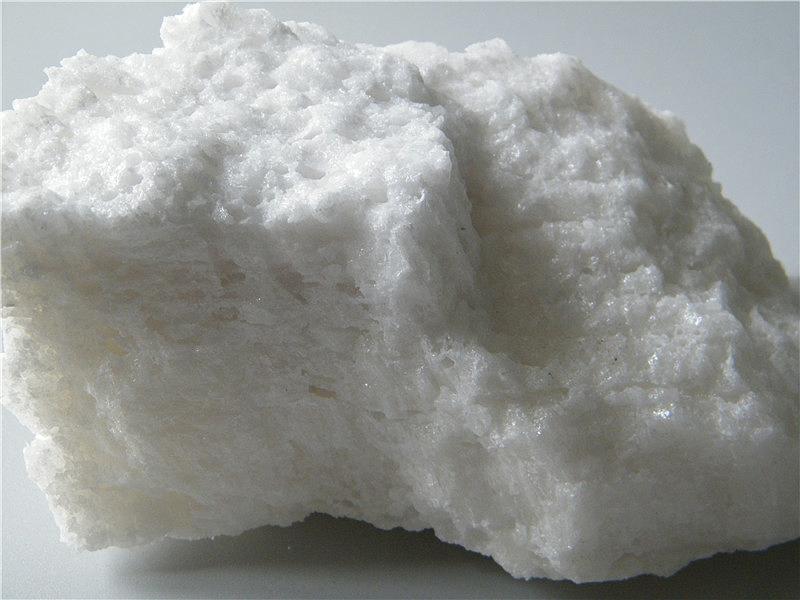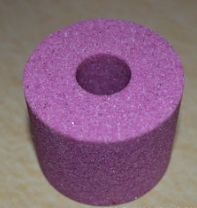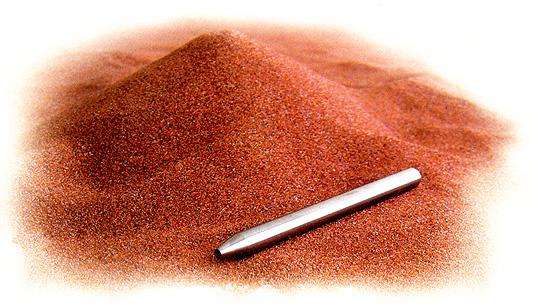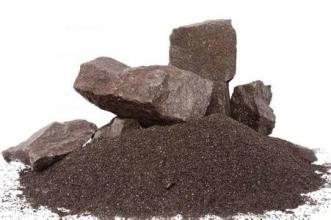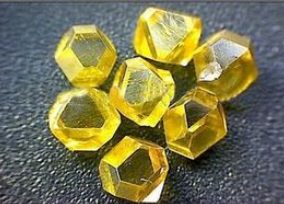Diamond
definition:
There are two types of allotropes of carbon: natural and artificial.
Diamond Diamond is commonly known as "diamond". Diamond, also known as diamond, is a mineral composed of pure carbon. Diamond is the hardest substance in nature. Diamond has many uses.
For example: cutting tools in crafts and industry. Carbon can form diamond under high temperature and pressure.
Diamond is the original stone of diamond and is a natural element mineral composed of carbon. The crystals are mostly octahedron, rhombohedral dodecahedron and cube, and sometimes polygonal. Most of them are colorless and transparent, but if they contain trace elements, they can appear in different tones such as brown, gray, white, etc. The crystal surface shows diamond luster, which is the strongest luster among natural colorless and transparent minerals. With a Mohs hardness of 10, it is the hardest substance naturally occurring in nature. Relative density 3.52. It is brittle and has good wear resistance. Does not conduct electricity. It has good thermal conductivity, and its thermal conductivity is 5 times that of copper at room temperature. The melting point is as high as 4000 degrees Celsius, and the combustion temperature in air is 850-1000 degrees Celsius. Hydrophobic and lipophilic. Diamond is formed under high temperature and high pressure conditions deep in the earth, and is mainly produced in kimberlite, lamprophyre and eclogite. Southern Africa, Russia, Australia and other places are the world's major diamond producing areas. China's diamonds are mainly produced in Mengyin, Shandong, Wafangdian, Liaoning, and the Yuanjiang River Basin in Hunan. Diamond has a wide range of uses. Gem-grade diamond can be polished into diamonds. The thermal conductivity and resistivity of diamond are the highest among all substances. Nano-diamond films can be deposited on the surface of electronic component materials to reduce the size of their heat dissipation parts. The excellent infrared penetration of diamond can be used to create infrared windows for satellites and high-power lasers. On August 24, 1965, Team 809 of the Ministry of Geology discovered China's first primary diamond vein with industrial value, the Hongqi No. 1 kimberlite vein, in Changmazhuang, Mengyin. In 1966, China's first primary diamond mine was planned to be built in Changmazhuang. This was the Building Materials 701 Mine. Physical properties: It has the highest hardness among natural minerals, and its brittleness is also quite high. It will still break if hit hard. Derived from the ancient Greek word Adamant, which means hard and inviolable substance, it is recognized as the king of gemstones. Diamond. In other words, diamond is actually a very dense carbon crystal. Common shapes: round, oval, marquise, heart, pear, square, triangle and emerald. Round diamonds are the most common shape. Main origins: The main origins of diamonds are Australia, Botswana, Canada, Zimbabwe, Namibia, South Africa, Brazil, and Siberia; the current major diamond cutting centers in the world are: Antwerp, Belgium, Tel Aviv, Israel, New York, the United States, Mumbai, India, and Bangkok, Thailand. Antwerp is known as the "Diamond Capital of the World". About half of the world's diamond transactions are completed here. "Antwerp Cut" is synonymous with perfect cutting. The chemical composition of diamonds is carbon, which is the only single element among gemstones and belongs to the equiaxed crystal system. It often contains 0.05%-0.2% impurity elements, the most important of which are N and B. Their presence is related to the type and properties of diamonds. The crystal shapes are mostly octahedron, rhombohedral dodecahedron, tetrahedron and their polymorphs. Pure diamonds are colorless and transparent, showing different colors due to the mixing of trace elements. Strong diamond luster. The refractive index is 2.417 and the dispersion is medium, 0.044. Homogeneous body. Thermal conductivity is 0.35 cal/cm/sec/degree. Tested with a thermal conductivity meter, the response is the most sensitive. With a hardness of 10, it is the hardest mineral known so far. Its absolute hardness is 1,000 times that of quartz and 150 times that of corundum. It is afraid of heavy blows and will cleave and break after a heavy blow. A set of cleavages is complete. Density 3.52 g/cm3. Diamonds are luminescent and can emit light cyan phosphorescence at night after being illuminated by sunlight. X-ray irradiation emits sky blue fluorescence. The chemical properties of diamond are very stable and are not easily soluble in acids and alkali at room temperature, and acids and alkali will not affect it. The difference between diamonds, similar gemstones, and synthetic diamonds. Common substitutes or fakes in the gem market include colorless gemstones, colorless spinel, cubic zirconia, strontium titanate, yttrium almandine garnet, yttrium gallium garnet, and artificial rutile. Synthetic diamonds were first successfully developed in Japan in 1955, but were not mass produced. Because synthetic diamonds are more expensive than natural diamonds, synthetic diamonds are rare on the market. Diamonds can be distinguished from similar gemstones by their unique hardness, density, dispersion, and refractive index. For example: imitation diamond cubic zirconia is mostly colorless, has strong dispersion (0.060), strong gloss, and high density of 5.8 g/cubic centimeter, and it feels heavy when weighed by the hand. Yttrium almandine has a soft dispersion and is difficult to distinguish from diamonds with the naked eye. diamond hardness Mohs hardness 10, new Mohs hardness 15, microhardness 10000kg/mm2, microhardness 1000 times higher than quartz and 150 times higher than corundum. The hardness of diamond is directional. The hardness of the octahedral crystal face is greater than the hardness of the rhombic dodecahedral crystal face. The hardness of the rhombic dodecahedral crystal face is greater than the hardness of the hexahedral crystal face. According to the Mohs hardness scale, there are 10 levels. Diamond is the highest level, level 10. For example, the hardness of a knife is about 5.5, a copper coin is about 3.5 to 4, a fingernail is about 2 to 3, and the hardness of glass is about 5.5. is 6.

